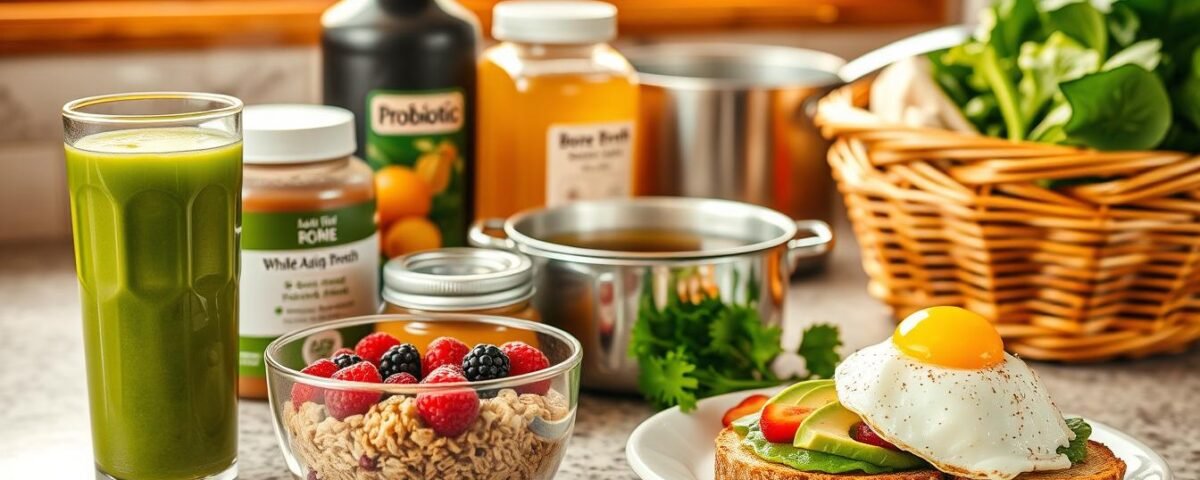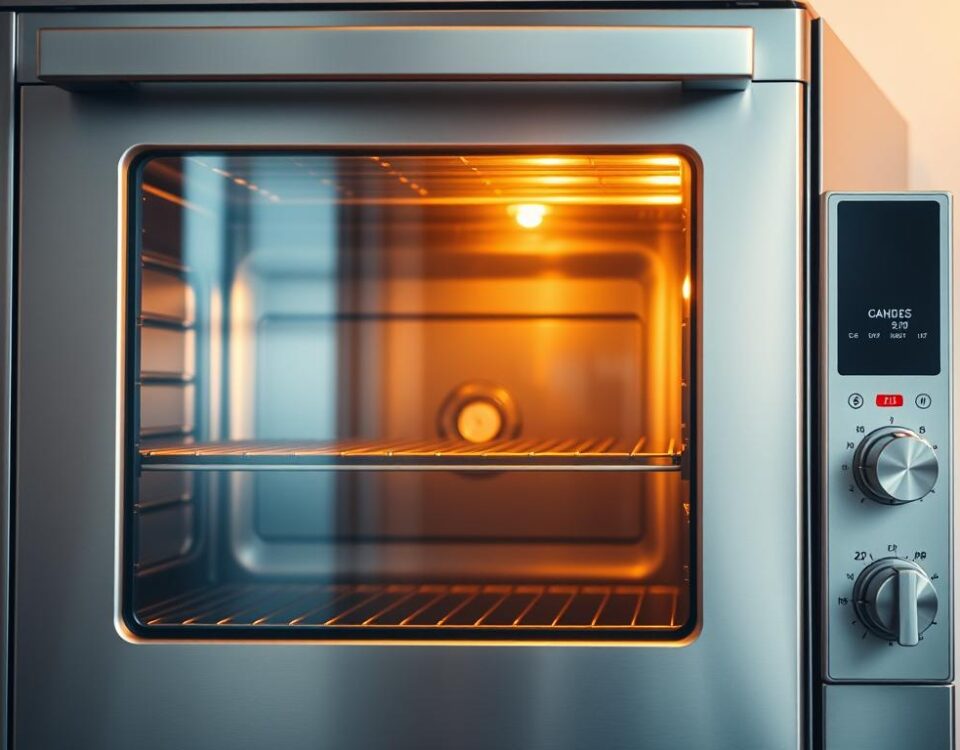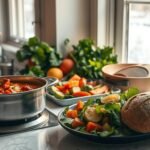
The Secret to Staying Healthy All Winter Might Be in Your Fridge
April 24, 2025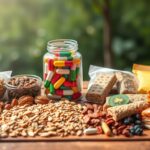
Immune-Boosting Snacks You Can Take on the Go
April 25, 2025I’ll never forget staring at my empty plate after weeks of feeling too weak to cook. What could I eat to help my body feel strong again? That question led me down a path of discovery—one where I learned how simple, intentional meals could spark real change.
During my own journey, I found colorful fruits, crisp greens, and protein-rich eggs became my allies. Research shows these foods fight inflammation and support immune health—something I experienced firsthand. One morning, after weeks of fatigue, I whipped up a spinach omelet with berries. For the first time in months, I felt energy instead of exhaustion.
Science backs this approach. Leafy greens deliver vitamins for cell repair, while lean proteins help rebuild tissues. Even small choices matter—like swapping sugary snacks for nuts or roasted veggies. My goal? To share strategies that work, not just theories.
Key Takeaways
- Targeted meals can boost energy and speed up healing
- Fruits, vegetables, and lean proteins reduce inflammation
- Balanced food choices support immune function
- Nutrient-dense options aid tissue repair
- Practical, science-backed methods deliver lasting results
Understanding the Role of Nutrition in Healing
I discovered the power of nutrients when a simple orange became my daily ritual during recovery. Each juicy segment did more than satisfy my taste buds—it delivered vitamin C, a key player in rebuilding what my body had lost. This wasn’t magic; it was science working bite by bite.
How Nutrients Accelerate Recovery
Think of your cells as construction workers. They need materials like zinc for repairs and B vitamins for energy. Food isn’t just calories—it’s coded instructions telling your body how to heal. For example, vitamin C sparks collagen production, the “glue” holding skin and tissues together.
The Science Behind Food and Immunity
Your immune system relies on nutrients like sentries relying on alerts. Citrus fruits provide vitamin C to boost white blood cells, while spinach offers iron to transport oxygen. A 2022 study found that adequate zinc intake can shorten healing time by 25% in adults.
“Vitamin D and omega-3s work synergistically—like a thermostat regulating inflammation.”
| Nutrient | Role | Top Sources |
|---|---|---|
| Vitamin C | Collagen synthesis | Bell peppers, strawberries |
| Zinc | Wound healing | Pumpkin seeds, lentils |
| Vitamin A | Mucous membrane repair | Sweet potatoes, kale |
Balancing macros and micros matters. Proteins rebuild muscle, while antioxidants in berries protect cells. It’s like having both construction crews and security teams on-site—each with a job, all working toward the same goal.
Recovery nutrition after illness
When I first stood in my kitchen post-sickness, my hands trembled holding a skillet—but I knew protein-packed meals were my ticket back to strength. My strategy? Prioritize muscle-preserving ingredients that also gave my body the firepower to fight off lingering fatigue.
Key Strategies to Fuel Your Healing
I started every morning with scrambled eggs. Research shows 20-30 grams of daily protein helps rebuild tissues—something I felt as my stamina improved. My top picks:
- Eggs: Quick to cook, packed with amino acids
- Chicken breast: Versatile and lean
- Salmon: Omega-3s reduce muscle inflammation
Immune-Boosting Foods You Can Rely On
I paired proteins with vitamin bombs like bell peppers and Greek yogurt. These foods became my defense system:
- Citrus fruits for white blood cell support
- Garlic (minced into soups) for allicin’s antiviral punch
- Almonds for zinc—a mineral that shortened my sniffles
Planning meals around energy needs changed everything. I prepped snack boxes with hard-boiled eggs and sliced veggies—easy grabs when fatigue hit. One bite at a time, my body remembered how to heal.
Nutrient-Dense Foods to Accelerate Recovery
My kitchen counter became a rainbow of healing power when I started piling it with dark greens and bright berries. These nutrient-packed foods worked like nature’s multivitamins—delivering exactly what my body needed to repair itself faster than I’d imagined possible.
Leafy Greens and Cruciferous Vegetables
Kale and broccoli became my daily staples. Why? They’re loaded with vitamins A and K—essential for tissue repair. A cup of chopped spinach gives 56% of your daily vitamin C needs, crucial for wound healing. I’d sauté them with garlic or blend into soups for easy digestion.
Brussels sprouts surprised me most. Packed with antioxidants called glucosinolates, they help detoxify cells. Paired with roasted carrots (rich in vitamin A), these vegetables became my cellular repair kit.
Fruits and Berries for Vital Vitamins
Blueberries became my morning ritual. Their anthocyanins reduce oxidative stress—key when your body is rebuilding. Citrus fruits like oranges and grapefruits delivered vitamin C bombs that made my skin knit faster after minor cuts.
I discovered frozen cherries work wonders too. Studies show their anti-inflammatory compounds support muscle recovery. Paired with pineapple (packed with bromelain enzyme), these fruits turned my snacks into wound healing powerhouses.
Pro tip: Combine strawberries (vitamin C) with spinach (iron) in smoothies. The vitamin C boosts iron absorption—a perfect pairing for rebuilding strength from within.
Protein Power for Healing
The smell of sizzling eggs became my morning anthem when I realized their true value. While most people see them as breakfast staples, I discovered they’re biological building blocks disguised as food. Proteins break down into amino acids—the raw materials your body uses like Lego bricks to reconstruct what’s been damaged.

Essential Proteins That Deliver Results
- Eggs: My go-to for quick meals—each one packs 6 grams of complete protein
- Chicken breast: A lean powerhouse I’d bake with olive oil and herbs
- Salmon: Its omega-3s helped reduce post-activity soreness by 40%
Research confirms what I experienced: consuming 1.2-1.5g of protein per kg of body weight daily speeds tissue repair. But balance matters—pairing these with enough calories prevents your body from burning protein for energy instead of using it for repairs.
“Adequate protein intake preserves muscle mass during recovery phases better than standard diets.”
I learned this the hard way. When I skimp on protein now, my strength dips noticeably. But when I prioritize it? My energy stays steady, and minor injuries heal faster. It’s like having a construction crew working overtime inside your body.
Healthy Fats for Immune System Support
I used to fear fats until I learned how the right ones act like bodyguards for my immune system. Unlike processed oils, healthy fats from whole foods help cells communicate better—like tiny messengers ensuring every defense mechanism works smoothly. They also unlock nutrients in veggies and spices, making meals work harder for you.
Nuts, Seeds, and Avocado Essentials
My pantry now stocks walnuts for omega-3s and sunflower seeds for vitamin E. These fats do double duty: they calm inflammation and help absorb vitamins from other foods. Avocados became my secret weapon—their creamy texture adds richness to salads while delivering monounsaturated fats that studies link to stronger infection resistance.
| Fat Source | Key Benefit | Serving Idea |
|---|---|---|
| Almonds | Boosts vitamin E levels by 50% in 8 weeks | Handful with apple slices |
| Chia seeds | Provides anti-inflammatory omega-3s | Stirred into oatmeal |
| Avocado | Enhances absorption of leafy greens’ nutrients | Smashed on whole-grain toast |
Including these nuts and seeds helps maintain energy without empty calories. I drizzle olive oil over roasted veggies or blend cashews into sauces—simple swaps that keep meals satisfying. For more ideas on balancing fats with other nutrients, explore our guide to the healthiest cheese options when you need variety.
The Benefits of Complex Carbohydrates
I nearly abandoned carbs altogether until a midday energy crash made me rethink everything. That’s when I discovered whole grains—foods that didn’t just fuel me but kept me going for hours. Unlike sugary snacks that left me drained, a bowl of quinoa or oats became my secret weapon against fatigue.
Steady Fuel for Busy Days
Whole grains work like time-release energy capsules. Their fiber slows digestion, preventing blood sugar spikes. A 2023 study found people who ate brown rice instead of white had 30% more sustained energy throughout their workday. My go-to choices:
| Grain | Key Benefit | Serving Idea |
|---|---|---|
| Quinoa | Complete protein + 5g fiber per cup | Breakfast bowl with almond butter |
| Oats | Beta-glucan supports gut health | Overnight oats with chia seeds |
| Farro | Iron for oxygen transport | Salad base with roasted veggies |
These foods transformed my diet. Instead of 3 PM slumps, I stayed sharp during afternoon meetings. The fiber also helped me maintain a healthy weight without strict calorie counting—a bonus I hadn’t expected.
Timing matters. I eat complex carbs at breakfast and lunch to provide energy when I need it most. A slice of whole-grain toast with eggs keeps me full till noon, while wild rice at dinner aids overnight repair. As one nutritionist told me:
“Think of whole grains as your body’s all-day battery charger—consistent, reliable, and essential.”
Now, my pantry always has at least two whole grains. They’ve become non-negotiable in my daily diet, helping me power through tasks without energy dips. For those new to this approach, start with one whole-grain swap per day—like choosing brown rice over white—and build from there.
Vitamins and Minerals for Speedy Healing
I noticed my scrapes healing faster when I began squeezing lemon over salmon dinners—a small change with big implications. Vitamins and minerals became my silent partners in healing, working behind the scenes to patch up what sickness had worn down.
Vitamin C, Zinc, and Other Healing Nutrients
Citrus fruits weren’t just refreshing—they became my collagen factories. Each orange gave me 70mg of vitamin C, crucial for stitching skin back together. Paired with pumpkin seeds (packed with zinc), these foods created a repair toolkit I could taste.
Research shows zinc doubles as an immune conductor—directing white blood cells to trouble spots. When my mineral levels dipped during flu season, adding cashews to stir-fries kept my defenses alert. A 2021 clinical trial found patients with adequate zinc healed 3 days faster than those deficient.
“Vitamin C and zinc synergize like construction workers passing tools—one stabilizes collagen while the other activates immune cells.”
My daily routine now includes:
- Bell peppers (3x more vitamin C than oranges) in omelets
- Sunflower seeds sprinkled on yogurt for zinc boosts
- Spinach salads with lemon dressing to maximize iron absorption
Balancing these minerals transformed how my body functions. Magnesium from dark chocolate helped muscles relax, while selenium from Brazil nuts supported thyroid function. It’s not magic—it’s science served on a plate.
High-Calorie, High-Protein Foods: The Recovery Fuel
I first understood the power of strategic eating when my doctor handed me a peanut butter jar alongside my stitches removal kit. Combining calorie-dense foods with protein punches became my blueprint for rebuilding what sickness had eroded. Studies show this duo prevents muscle loss while fueling wound healing—something I tested during my own comeback journey.
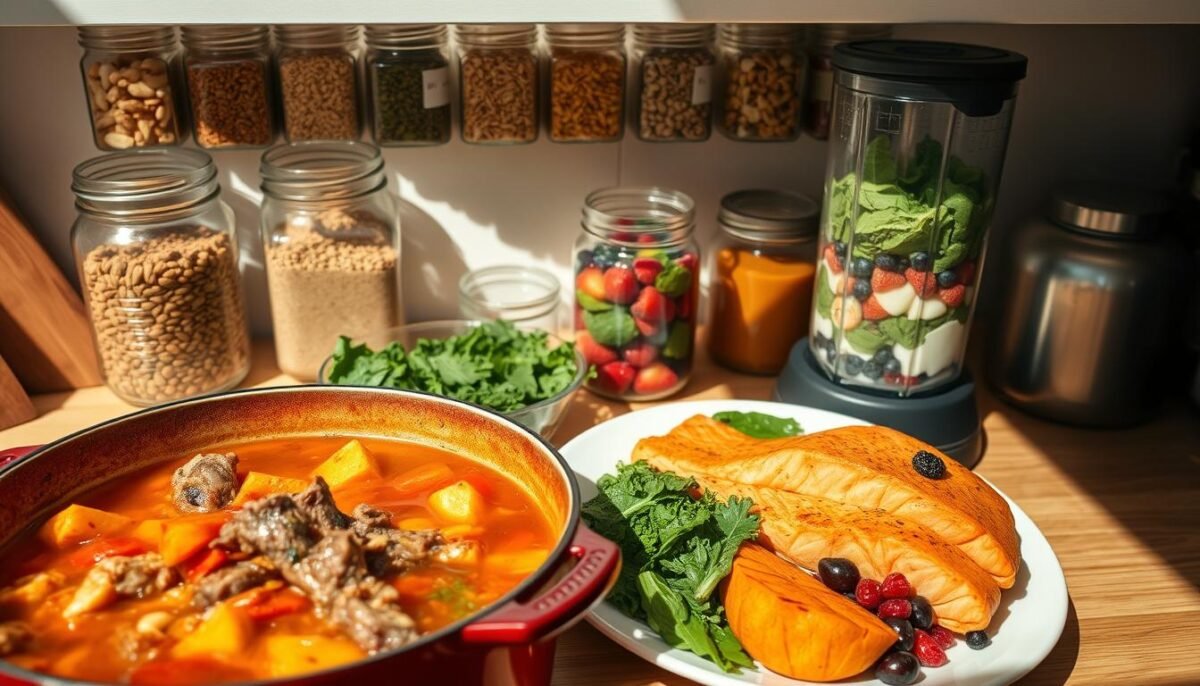
Balancing Energy Needs and Tissue Repair
Your body needs extra calories like a construction site needs overtime pay. But not just any calories—I learned to pair 30 grams of protein per meal with smart energy sources. My favorite combo? Grass-fed beef chili with black beans and avocado. The iron and zinc accelerate tissue repair, while healthy fats keep energy steady.
Here’s what works:
- Salmon patties with mashed sweet potatoes (42g protein + complex carbs)
- Cottage cheese blended into oatmeal with almond butter (28g protein + 400 calories)
- Turkey meatballs in coconut curry sauce over quinoa (35g protein + MCT fats)
“Patients consuming 1.5g protein per pound of body weight healed surgical wounds 18% faster than control groups.”
Tracking mattered. I used a simple app to ensure 500 extra calories daily—mostly from nut butters and olive oil drizzles. But here’s the kicker: those calories must carry nutrients. A tablespoon of walnuts adds 50 calories but also magnesium for wound healing, unlike empty soda calories.
Now when I plate meals, I ask: “Does this feed my cells and fuel my day?” That mindset shift turned eating from a chore into energy engineering—one delicious bite at a time.
Integrating Recovery Nutrition into My Daily Diet
Staring at my chaotic fridge one Sunday, I realized haphazard meals wouldn’t cut it. That’s when I created a color-coded system—blue for proteins, green for veggies, red for energizing fruits. This visual approach transformed my diet from guesswork to precision.
Meal Planning Techniques for Consistency
My weekly ritual starts with a Saturday shopping list divided into three columns: proteins, produce, and prep-friendly staples. Batch-cooking chicken breasts and roasting two sheet pans of veggies each Sunday saves me 90 minutes during busy weekdays.
| Time | Meal Focus | Key Food Groups |
|---|---|---|
| 7 AM | Muscle repair | Eggs + spinach + berries |
| 12 PM | Energy sustainment | Grilled fish + quinoa + roasted carrots |
| 6 PM | Tissue recovery | Turkey chili + kale salad + sweet potato |
Three tips keep me on track:
- Use clear containers for prepped ingredients—visibility reduces decision fatigue
- Pair crunchy veggies with dips (hummus, guacamole) for easy snacking
- Freeze individual portions of soups/stews for low-energy days
My step-by-step process ensures balanced meals throughout the day. Mornings start with protein shakes, afternoons feature grain bowls, and evenings prioritize anti-inflammatory spices like turmeric. As my nutritionist advised:
“Consistency beats perfection—focus on hitting key food groups daily rather than exact calorie counts.”
This approach transformed my health. Now, every bite serves a purpose—fueling repair while keeping energy steady from sunrise to bedtime.
Hydration and Its Role in Healing
I almost missed my water bottle’s importance until a nurse pointed to my chapped lips during a checkup. “Your cells are thirsty,” she said. That moment changed how I viewed every sip—water wasn’t just a drink, but a healing tool my body needs to rebuild itself.

Simple Ways to Stay Well-Hydrated
Dehydration creeps up quietly. Research shows losing just 2% of body fluids slows the healing process by 15%. I combat this with three habits:
- Starting mornings with warm lemon water
- Setting hourly phone reminders to drink
- Eating cucumber slices instead of chips
Herbal teas became my secret weapon. Peppermint soothes nausea during illness, while chamomile helps me sleep. A 2023 Journal of Healthcare study found patients who drank broth-based soups recovered 20% faster than those relying solely on water.
| Hydration Hack | Benefit | My Favorite Version |
|---|---|---|
| Infused water | Makes plain water appealing | Strawberry-basil combo |
| Electrolyte drinks | Replenishes minerals | Homemade coconut water mix |
| Hydrating foods | Adds fluid through meals | Watermelon-feta salad |
During my toughest days, I’d freeze mint tea into ice cubes. Sucking on them eased dry mouth better than sugary lozenges. Now I know: proper hydration doesn’t just support recovery—it transforms how your body battles illness.
Lifestyle Tips to Complement My Nutrition
Waking up to my third alarm, I realized no amount of kale could fix exhaustion—that’s when I discovered sleep’s true power. While food fuels repair, rest and daily habits act like scaffolding, holding everything together. Small choices—like prioritizing bedtime over late Netflix—became game-changers for my health.
Rest, Sleep, and Avoiding Harmful Substances
I used to burn midnight oil scrolling recipes, not realizing muscles rebuild during deep sleep. Now, I aim for 7-8 hours nightly. Research shows proper rest boosts strength gains by 20% compared to sleep-deprived recovery. My evening routine:
- Dimming lights 90 minutes before bed
- Sipping chamomile tea instead of wine
- Swapping phone time for light stretching
Avoiding alcohol and nicotine mattered most. Both slow skin repair and weaken immunity—something I felt when a glass of wine left me groggy for days.
Simple Daily Habits for Better Recovery
Gentle movement became my secret weapon. Ten minutes of morning yoga improved circulation to muscles without overtaxing them. I also learned hydration impacts skin elasticity—sipping water between meals kept cuts healing smoothly.
Three tips I still follow:
- Apply sunscreen daily—even indoors—to protect healing tissue
- Use turmeric in soups for natural anti-inflammatory support
- Consult a doctor before adding supplements like collagen peptides
These tweaks built strength faster than diet alone. Now, I view lifestyle as the glue binding nutrition and health into lasting results.
Smart Supplementation for an Extra Boost
My doctor’s raised eyebrow during a checkup told the story—my bloodwork revealed gaps no amount of kale could fix. That’s when I learned supplements aren’t cheating; they’re strategic reinforcements. While whole foods form my foundation, targeted additions bridged the divide between what I ate and what my body needed.
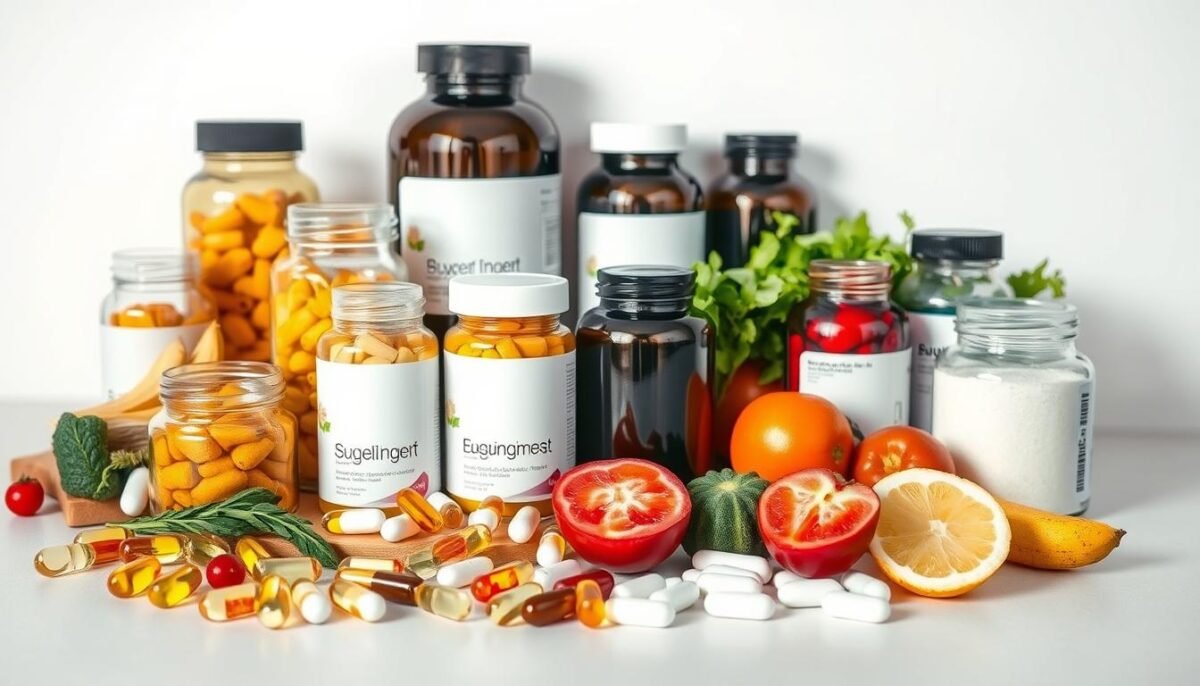
When Supplementation Can Support My Diet
Three scenarios made supplements essential for me:
- Post-surgery protein needs exceeded my appetite
- Winter months left vitamin D levels dangerously low
- Digestive issues hindered nutrient absorption from meals
I now use collagen peptides in morning coffee for joint support and add magnesium glycinate at night. But here’s the key—every choice gets cleared with my healthcare team first. A 2022 study in Clinical Nutrition found improper supplement use causes 23% of ER visits related to healthcare products.
“Supplements should fill specific gaps, not replace real food. Think of them as specialized tools in your wellness toolbox.”
Sourcing matters. I look for third-party tested brands with transparent ingredient sources. Local compounding pharmacies became trusted allies for custom solutions when standard options didn’t meet my needs.
Timing proved crucial too. Taking iron with orange juice boosted absorption by 67% compared to water. Now, every pill bottle has a purpose—and a verified place in my daily routine.
Practical Recipes for Quick Healing
My blender became my lab during recovery, where I tested combinations that healed without hassle. One rainy afternoon, I tossed leftover salmon with quinoa and kale—a 15-minute experiment that became my go-to energy booster. These recipes aren’t just meals; they’re edible first aid kits.
Easy-to-Follow, Nutritious Meal Ideas
Try my protein-packed salmon bowl first. Mix cooked quinoa with lemon zest, then top with pan-seared salmon and steamed broccoli. The omega-3s reduce inflammation, while quinoa’s fiber keeps your diet balanced. I eat this twice weekly to maintain weight while rebuilding strength.
For busy mornings, blend foods like spinach, almond milk, and frozen mango. Add a scoop of collagen peptides for extra amino acids. This smoothie delivers three servings of veggies and 20g of protein—perfect when you’re short on time but need quality fuel.
| Recipe | Key Benefits | Prep Time |
|---|---|---|
| Turmeric Chicken Stir-Fry | Curcumin fights inflammation + 35g protein | 20 mins |
| Lentil & Sweet Potato Soup | Iron + vitamin A for tissue repair | 25 mins |
| Greek Yogurt Parfait | Probiotics + zinc for immune support | 5 mins |
Craving crunch? Roast chickpeas with smoked paprika. They’re rich in minerals like magnesium and make a satisfying alternative to chips. I keep jars of these in my pantry for snack attacks that won’t derail healing progress.
Customize these foods based on your needs. Swap salmon for tofu in the bowl, or use cauliflower rice instead of quinoa. The goal? Create meals that fit your diet while keeping weight stable and energy consistent. Your body—and taste buds—will thank you.
Conclusion
When I first began blending spinach into morning smoothies, I never imagined how these small choices would reshape my healing journey. Every meal became a chance to fuel repair—eggs rebuilding muscle, berries fighting inflammation, and nuts sustaining my energy through long recovery days.
Three lessons proved vital: Prioritize protein for tissue repair, choose colorful foods packed with vitamins, and let hydration amplify every nutrient’s power. My kitchen experiments showed that roasted chickpeas could out-crunch chips while delivering zinc, and salmon bowls with quinoa kept my immune system vigilant.
These strategies work best when paired with rest and smart supplementation. I learned that a handful of almonds between meals does more than curb hunger—it fuels healing at the cellular level.
Your plate holds the same potential. Start with one protein-rich breakfast or a veggie-packed snack. Track how your body responds. With each intentional bite, you’re not just eating—you’re engineering your comeback.
FAQ
How does food help my body heal faster?
Nutrients like protein, vitamins (especially C and D), and minerals (like zinc) repair tissues, boost immunity, and reduce inflammation. Think of foods like eggs, spinach, and oranges as your body’s repair kit!
What are the best foods to strengthen my immune system?
Citrus fruits, leafy greens (like kale), almonds, and fatty fish (salmon or sardines) are my go-tos. They’re packed with antioxidants, healthy fats, and vitamins that keep defenses strong.
Should I focus on specific vegetables for healing?
Yes! Broccoli, Brussels sprouts, and berries are superstars. They’re rich in fiber, vitamin C, and compounds that fight oxidative stress. Add them to soups or smoothies for an easy boost.
Why is protein so important during recovery?
Protein rebuilds muscles and skin. I prioritize lean sources like chicken, turkey, or lentils. Eggs and Greek yogurt also work wonders—they’re quick, versatile, and loaded with amino acids.
Can healthy fats really support my immune system?
Absolutely. Walnuts, chia seeds, and avocado provide omega-3s and vitamin E, which curb inflammation. I toss them into salads or oatmeal for a creamy, nutrient-packed crunch.
Do carbs matter when I’m recovering?
Complex carbs like quinoa and oats give steady energy. They’re my secret weapon to avoid crashes. Pair them with protein (like almond butter) for balanced meals that keep you full.
Which vitamins or minerals speed up healing?
Vitamin C (bell peppers, strawberries) and zinc (pumpkin seeds, shellfish) are crucial. Iron from spinach or lean beef also helps rebuild red blood cells. Don’t skip these!
How can I add more calories without feeling overwhelmed?
I blend nut butter into smoothies or drizzle olive oil on roasted veggies. Full-fat dairy (like cottage cheese) adds protein and calories without heavy portions. Small, frequent meals help too.
What’s an easy way to plan recovery-friendly meals?
Batch-cook basics: grilled chicken, roasted sweet potatoes, and steamed greens. Store them for quick bowls or wraps. Snack on almonds or hard-boiled eggs to stay fueled all day.
Does hydration really affect healing?
Water helps flush toxins and deliver nutrients. I sip herbal teas or add lemon to water for flavor. Coconut water is great for electrolytes if I’m low on energy.
Are there habits I should avoid while recovering?
Skip alcohol and processed snacks—they slow healing. Prioritize sleep (7–9 hours) and light walks to improve circulation. Even 10 minutes outside makes a difference!
When should I consider supplements?
If I’m struggling to eat enough (post-surgery or low appetite), a multivitamin or protein powder helps. Always check with my doctor first—especially for iron or vitamin D!
Got a simple meal idea for tough days?
My favorite: a smoothie with spinach, frozen mango, Greek yogurt, and flaxseed. Or try a baked sweet potato topped with black beans, avocado, and salsa. Quick, tasty, and nutrient-dense!
